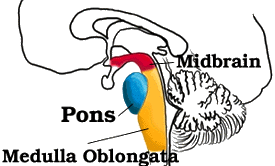Brain Stem Injury can Cause Death and Catastrophic Damage
Brain Stem Injury
By Gordon S. Johnson, Jr.
Brain Stem Injury is often catastrophic because damage to the brain stem involves injury to the autonomic nervous system, which controls heart and breathing. While brain stem injury can stem directly from trauma, the biggest risk factor in most severe brain injuries, is the risk of herniation of the cerebral cortex into the brain stem area.Herniation of the Brain Stem in Severe Brain Injury

The brain stem is made up of the Midbrain, the Pons and the Medulla Oblongata.
Herniation means to bulge out, similar to what would happen with a spinal disk bulge. A herniation of the brain into the cavity of the skull where the brain stem resides will cause a compression of the brain stem. Since the brain stem regulates the involuntary nervous system which controls heart rate, breathing and blood pressure, such injury can result in a rapid death.
The brain stem is in the lower part of the brain, and includes the Midbrain, Pons and Medulla Oblongata. See image to the right.
The Midbrain
The Midbrain is more formally called the mesencephalon. The midbrain is on the top part of the brainstem. The midbrain is the part of the brain stem that is closest to the cerebral cortex. The midbrain is separated into an anterior and a posterior section, which connect the third and fourth ventricles. Motor tracts (axonal tracts which control the muscles) pass along the midbrain’s anterior surface (near the front). Sensory axons (those with which we feel touch and other senses) run behind the motor tracts.
The Pons
The Pons is below the Midbrain and above the Medulla Oblongata. Motor and sensory tracts lay along the front surface of the pons. Here the sensory axons are located behind the motor axons. The tracts of cranial nerves V and VI are located in the pons. Cranial Nerve V which is the trigeminal nerve, sends commands to the jaw and receives sensory messages from the tongue, teeth and parts of the face. Cranial Nerve VI, the abducens nerve, provides motor commands to the eye.
The nucleus of cranial nerve VII, the facial nerve, is on the boundary of the Pons and Medulla Oblongata. The higher part of the nerve controls the muscles which control facial expression as well as eye lids, forehead and the lips. The lower part of the facial nerve controls the voluntary muscles of the face which are below the eyelids.
The Medulla Oblongata
The Medulla Oblongata is in the deepest part of the brain stem. The cell nucleus of several cranial nerves are found in the Medulla Oblongata.